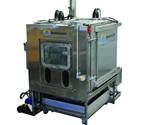CAD/CAM Software Has New 2.5-Axis Waveform Strategy for High-Speed Machining
Vero Software’s Visi 2017 R2 has several new and enhanced features, including the 2.5-axis Waveform Strategy that maintains constant tool cutting load.
The Visi 2017 R2 from VISI by Vero Software has several new and enhanced features. Among them is the new 2.5-axis Pocketing Strategy, which Vero Software says improves toolpath quality, optimizes toolpath on open features, and enables machining from a stock model. When the stock model is defined, the new Pocketing Strategy can identify the areas where it is necessary to remove the material and adapt the toolpath to produce passes only when they are needed.
With this latest release, the new 2.5-Axis Waveform Strategy (previously available in 3D roughing) enables high-speed machining. The company says that the Waveform Strategy maintains constant tool cutting load, constant cutting feed rate and a smooth toolpath that avoids sharp changes in direction.
Based on the Pocketing technology, Visi’s new Re-machining Strategy inherits the same enhancements and advantages. Rest area recognition is achieved automatically, based on the reference operations. A new residual stock algorithm is used for both 2D and 3D operations and the Dynamic Incremental Stock command, which Vero says ensures consistent toolpath quality regardless of the operation type.
Related Content
-
Four Micro Tooling Considerations
Issues involving gating, ejection, mold splits and direction of pull are of special concern when it comes to micro tooling.
-
Tips for Tackling Mold Design, Machining, Cutting Tool and Wear Challenges
Tips for tasks ranging from reducing risk in part design and taking advantage of five-axis machining to refining cutting tool performance and reducing wear with guiding and centering systems.
-
Mold Design Review: The Complete Checklist
Gerardo (Jerry) Miranda III, former global tooling manager for Oakley sunglasses, reshares his complete mold design checklist, an essential part of the product time and cost-to-market process.












